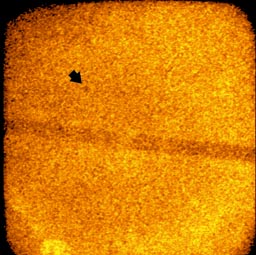The conclusion? "If you strip the 'noise' from the data," notes Frank, "what remains clearly validates the reality of atmospheric holes. The critics who have studied the data and say the atmospheric holes are noise have mistakenly and quite remarkably--been analyzing the noise itself."
To coincide with the publication of their ground-breaking, peer-reviewed paper entitled "Atmospheric Holes: Instrumental and geophysical Effects" in the Journal of Geophysical Research [ Full Text], Frank and Sigwarth have released several new images from NASA's Polar spacecraft, showing more of the atmospheric holes and the remarkable small comets that produce them.
In their latest study, Frank and Sigwarth utilized an automated approach to searching for the atmospheric holes in the Polar images. The strict parameters of this new "hands-off" survey eliminates the effects of several instrumental artifacts, including those produced by energetic electrons in Earth's outer radiation zone, by "hot spots"--or non-uniform pixel sensitivities--in the sensor, and by the camera's sensitivity to long wavelength radiation produced by high altitude clouds.
